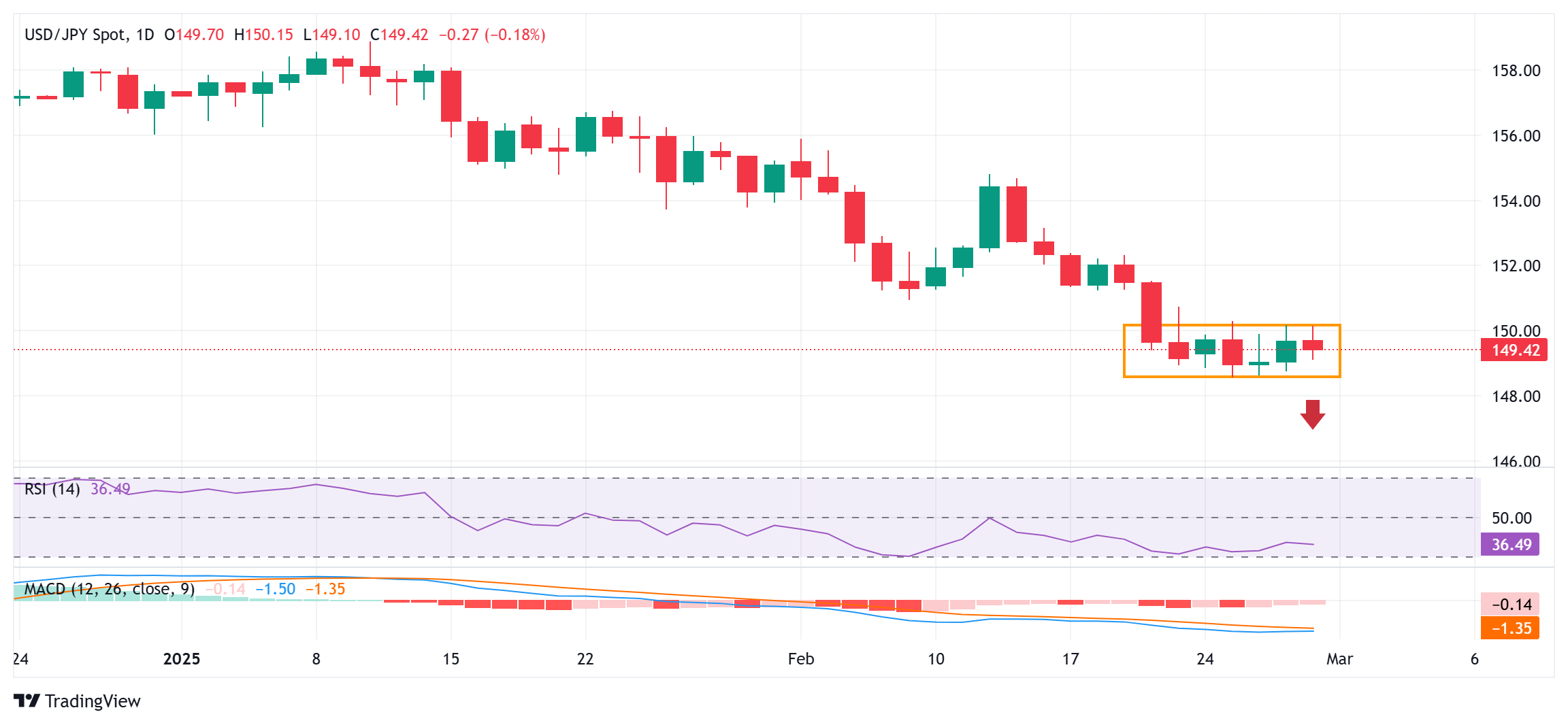Japanese Yen trims part of intraday gains against broadly stronger US Dollar

- The Japanese Yen regains positive traction amid rising bets for more BoJ rate hikes this year.
- The JPY bulls seem unaffected by the softer-than-expected Tokyo CPI released this Friday.
- Modest USD strength lends support to USD/JPY as the focus shifts to the key US PCE data.
The Japanese Yen (JPY) trims a part of its intraday gains against the broadly stronger US Dollar (USD), assisting the USD/JPY pair to recover nearly 50 pips from the Asian session low, around the 149.00 neighborhood. Any meaningful JPY depreciation, however, seems elusive in the wake of the growing market acceptance that the Bank of Japan (BoJ) will hike interest rates further this year. The bets were reaffirmed by BoJ Deputy Governor Shinichi Uchida’s remarks, saying that the underlying inflation rate is gradually rising toward the 2% target.
This helps offset the softer-than-expected Tokyo Consumer Price Index (CPI) print and should continue to act as a tailwind for the JPY. Apart from this, the risk-off impulse could further offer support to the safe-haven JPY. Meanwhile, the anti-risk flow triggers a fresh leg down in the US Treasury bond yields, resulting in the narrowing of the US-Japan rate differential. This should further contribute to limiting the downside for the lower-yielding JPY. The USD bulls might also opt to wait for the US Personal Consumption Expenditure (PCE) Price Index.
Japanese Yen bulls turn cautious amid some follow-through USD buying ahead of US PCE data
- Bank of Japan Deputy Governor Shinichi Uchida said this Friday that Japan’s inflation rate is gradually rising towards the central bank’s 2% target as the economy sustains a moderate recovery path.
- The Statistics Bureau of Japan reported that the headline Consumer Price Index (CPI) in Tokyo – Japan’s capital city – decelerated from 3.4% in the previous month to the 2.9% YoY rate in February.
- Meanwhile, core CPI – which excludes volatile fresh food prices – eased more than expected, from an 11-month high of 2.5% touched in January to the 2.2% YoY rate during the reported month.
- Furthermore, a core gauge that excludes both fresh food and energy prices, and is watched as a gauge of underlying inflation by the BoJ, came in at 1.9%, matching the previous month’s reading.
- Separately, Japan’s Industrial Production fell by 1.1% MoM in January. This follows a 0.2% decrease in the previous month and marks the third consecutive month of decline in industrial output.
- Investors, however, seem convinced that the BoJ will hike interest rates further, which, along with the risk-off mood, boosts the safe-haven Japanese Yen during the Asian session on Friday.
- The US Dollar stands firm near the weekly top in the wake of Thursday’s data, showing that inflationary pressures continue to rise and backing the case for the Federal Reserve to hold steady.
- The second reading of the US Gross Domestic Product showed that the economy expanded by a 2.3% annualized pace during the final quarter of 2024, matching the original estimate.
- Additional details of the report published by the US Bureau of Economic Analysis revealed that the GDP Price Index rose 2.4% compared to the initial estimate of 2.2%.
- This comes on top of worries that US President Donald Trump’s policies would reignite inflation and put additional pressure on the Federal Reserve to stick to its hawkish stance.
- Kansas City Fed President Jeff Schmid said that recent surveys indicate a rise in consumer inflation expectations and that the central bank must stay focused on fully containing price pressures.
- Cleveland Fed President Beth Hammack noted on Thursday that interest rates are likely on hold for the time being as inflation data starts to pose a growing problem for central policymakers.
- Philadelphia Fed President Patrick Harker noted that progress toward the 2% inflation target has slowed and that the policy rate remains restrictive to continue putting downward pressure on inflation.
- Investors now look forward to the release of the US Personal Consumption Expenditure (PCE) Price Index for cues about the Fed’s rate-cut path, which will drive the buck and the USD/JPY pair.
USD/JPY might continue with its struggle to build on momentum beyond the 150.00 mark
From a technical perspective, spot prices remain confined in a familiar range held since the beginning of this week. Against the backdrop of the recent decline from the vicinity of the 159.00 mark, or the year-to-date high touched in January, the range-bound price action might still be categorized as a bearish consolidation phase. The negative outlook is reinforced by the fact that oscillators on the daily chart are holding deep in negative territory and are still away from being in the oversold zone. This, in turn, suggests that the path of least resistance for the USD/JPY pair is to the downside and supports prospects for deeper losses.
In the meanwhile, the 149.00 round figure now seems to protect the immediate downside ahead of the 148.60-148.55 region, or the multi-month low touched on Tuesday. Some follow-through selling will be seen as a fresh trigger for bearish traders and drag the USD/JPY pair to the 148.00 mark en route to the next relevant support near the 147.35-147.30 area and the 147.00 round figure.
On the flip side, the 148.80 region, followed by the 150.00 psychological mark and the weekly high, around the 150.30 area, might continue to act as an immediate hurdle. A sustained strength beyond the latter, however, could trigger a short-covering rally and lift the USD/JPY pair further towards the 150.90-151.00 horizontal support breakpoint, now turned strong barrier. The momentum could extend further towards the 151.45 region en route to the 152.00 mark, though it is more likely to remain capped near the 152.40 zone. The latter represents the very important 200-day Simple Moving Average (SMA) and should act as a key pivotal point.
US Dollar PRICE Today
The table below shows the percentage change of US Dollar (USD) against listed major currencies today. US Dollar was the strongest against the New Zealand Dollar.
| USD | EUR | GBP | JPY | CAD | AUD | NZD | CHF | |
|---|---|---|---|---|---|---|---|---|
| USD | 0.16% | 0.22% | -0.10% | 0.02% | 0.39% | 0.53% | -0.04% | |
| EUR | -0.16% | 0.06% | -0.23% | -0.13% | 0.23% | 0.37% | -0.20% | |
| GBP | -0.22% | -0.06% | -0.30% | -0.19% | 0.17% | 0.31% | -0.26% | |
| JPY | 0.10% | 0.23% | 0.30% | 0.13% | 0.49% | 0.62% | 0.06% | |
| CAD | -0.02% | 0.13% | 0.19% | -0.13% | 0.36% | 0.51% | -0.06% | |
| AUD | -0.39% | -0.23% | -0.17% | -0.49% | -0.36% | 0.14% | -0.43% | |
| NZD | -0.53% | -0.37% | -0.31% | -0.62% | -0.51% | -0.14% | -0.57% | |
| CHF | 0.04% | 0.20% | 0.26% | -0.06% | 0.06% | 0.43% | 0.57% |
The heat map shows percentage changes of major currencies against each other. The base currency is picked from the left column, while the quote currency is picked from the top row. For example, if you pick the US Dollar from the left column and move along the horizontal line to the Japanese Yen, the percentage change displayed in the box will represent USD (base)/JPY (quote).
Information on these pages contains forward-looking statements that involve risks and uncertainties. Markets and instruments profiled on this page are for informational purposes only and should not in any way come across as a recommendation to buy or sell in these assets. You should do your own thorough research before making any investment decisions. FXStreet does not in any way guarantee that this information is free from mistakes, errors, or material misstatements. It also does not guarantee that this information is of a timely nature. Investing in Open Markets involves a great deal of risk, including the loss of all or a portion of your investment, as well as emotional distress. All risks, losses and costs associated with investing, including total loss of principal, are your responsibility. The views and opinions expressed in this article are those of the authors and do not necessarily reflect the official policy or position of FXStreet nor its advertisers. The author will not be held responsible for information that is found at the end of links posted on this page.
If not otherwise explicitly mentioned in the body of the article, at the time of writing, the author has no position in any stock mentioned in this article and no business relationship with any company mentioned. The author has not received compensation for writing this article, other than from FXStreet.
FXStreet and the author do not provide personalized recommendations. The author makes no representations as to the accuracy, completeness, or suitability of this information. FXStreet and the author will not be liable for any errors, omissions or any losses, injuries or damages arising from this information and its display or use. Errors and omissions excepted.
The author and FXStreet are not registered investment advisors and nothing in this article is intended to be investment advice.




